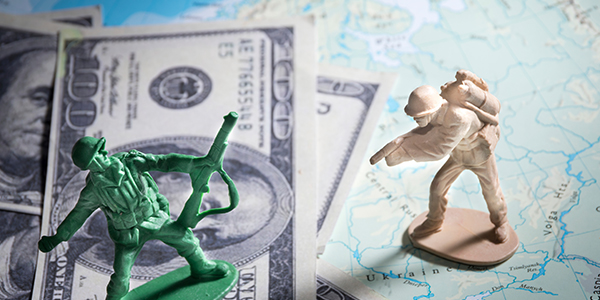How Should You Invest When We Face Hostile Threats?

|
|
Twenty-seven years and two weeks ago, Iraqi infantry and tanks poured across the border into Kuwait. Saddam Hussein’s lightning-fast invasion overwhelmed the defenders, and he seized the country in just two days of fighting.
Worse, the U.S. was largely caught by surprise on August 2, 1990. Officials knew Hussein was building up forces in the region, and that he was angry over the negative impact of Kuwaiti oil production on energy prices. But in the words of the New York Times:
“Despite Iraq’s heavy buildup of forces along the Kuwaiti border in late July, the Bush Administration was surprised by the invasion this week and largely unprepared to respond quickly, Administration officials say.”
The story went on to note that when news of the invasion broke …
“The National Security adviser, Brent Scowcroft, was at home, having taken an early evening off from his job. Defense Secretary Dick Cheney was preparing to accompany President Bush to Aspen, Colo., for a speech. The American Ambassador to Iraq was in London, having been told days before that she could take a holiday.”
We know what ultimately happened. The U.S. and its coalition allies rapidly coalesced into a powerful fighting force, and we drove Iraqi forces out of Kuwait in Gulf War I in early-1991. But Hussein was allowed to stay in power and cause ongoing trouble in the region, leading to Gulf War II and his ultimate demise more than a decade later.
Now, we’re in an increasingly bellicose war of words with another madman – North Korean leader Kim Jong-un. Just like Hussein flexed his muscles back then, Kim is launching missiles, conducting nuclear tests, and threatening “an enveloping fire” in Guam. President Trump is responding by threatening North Korea with “fire and fury like the world has never seen.”
So what do you do? Can you even invest in a world where we all might wake up to headlines of a pre-emptive U.S. strike in North Korea? Or missiles raining down on Guam (or God forbid, the U.S. mainland)?
First, let’s state the obvious: An actual nuclear battle would be catastrophic, something I don’t think anyone is truly prepared for. Nuclear weapons have only been used twice in the history of warfare (in Japan at the end of World War II), so there really isn’t even a possible blueprint to that kind of tragedy.
But let’s assume things don’t go that far. Let’s assume a “bad, but not entirely catastrophic” scenario where some kind of fight does break out. We’ve seen plenty of other simmering conflicts go “hot” over the years, and my research shows we tend to see a similar pattern in the markets. They tank as the pressures build, fall further when shooting breaks out, then rally if and when victory is achieved.
Look at 1990-1991. The Dow Jones Industrial Average started plunging in July as tensions rose in the Middle East. But after bottoming out in October, it started rallying once we launched Desert Storm. By March 1991, after Kuwait was liberated, it had gained back every penny it previously lost.
So what investment plans worked then, and are likely to work again now? I’m going to go into much more detail in my August issue of High Yield Investing. It goes to press this coming Monday the 14th, and it will contain concrete investment recommendations in addition to general guidance. So if you aren’t subscribed yet, get signed up now by clicking here. But to give you a broad overview of my thinking:
1. Defense stocks were among the strongest performance throughout the 1990-1991 crisis, and they held on to the lion’s share of those gains afterward.
2. Traditional safe haven plays like gold miners were a different story. They surged in the weeks before and immediately after the Kuwait invasion, but tanked after the allies pushed back.
3. Volatility gauges like the CBOE VIX Index soared when war broke out, remained elevated throughout the conflict, but ultimately plunged again when Kuwait was liberated.
All of this means defense stocks and ETFs are likely to be your best insurance plays and/or promising investments here. It’s no coincidence that many of them are setting all-time highs, including the PowerShares Aerospace & Defense Portfolio (PPA, Rated “B”). I sure hope you listened to me on multiple occasions earlier this year and invested in this sector, and I still think it has promise in the weeks and months ahead.
We’re also likely to see wild swings in ETFs that track volatility, not to mention gold, mining stocks, Treasury bonds, and other traditional safe havens. If you’re extremely nimble, you can buy something like the iPath S&P 500 VIX Short-Term Futures ETN (VXX, Rated “E”) and flip it if the VIX surges. But our SELL Rating … and the negative-70% “returns” over the last year … tell you everything you need to know about its suitability as a longer-term investment.
If North Korea frightens you, you’re better off owning something like one of the 21 ETFs we track whose objective is to invest in precious and base metals. This Precious Metals ETF Screener contains all of them, ranked in descending order by Weiss Rating. At the top are the iShares MSCI Global Silver Miners ETF (SLVP, Rated “C”) and the PowerShares DB Base Metals Fund (DBB, Rated “C”).
But even there, you have to be nimble because the fear premium any conflict will quickly inject can drain right back out just as quickly. Look at how the gold miners collapsed in late 1990.
As for other traditional ETFs you may own, you can expect them to pretty much tank across the board the second a headline like “Breaking News: North Korea Launches ICBM at Guam!” crosses the TV screen. But does that mean you should sell now and go to cash? I don’t think so.
For one thing, diplomacy may work and North Korea may back down. If that happens, the market’s march higher could turn into a sprint and you’d miss out on those gains.
For another thing, let’s say the market does tank for a period of time. That will sting. But we’ve faced a lot of conflicts as a nation before, conflicts that seemed a lot scarier at the time. I have to believe that good will ultimately prevail this time around, just as it did on those occasions.
Ultimately, unless and until we see signs of an impending recession or renewed ECONOMIC crisis that will crush earnings and sales prospects for Corporate America across the board, you’re likely better off buying into panic than selling. That was certainly the lesson of 1990-1991, and barring a catastrophic nuclear conflict, it’s what I’d counsel today.
Until next time,
Mike
ETF Spotlight Edition, by Mike Larson, Senior Analyst Mike Larson is a Senior Analyst for Weiss Ratings. A graduate of Boston University, Mike Larson formerly worked at Bankrate.com and Bloomberg News, and is regularly featured on CNBC, CNN, Fox Business News and Bloomberg Television as well as many national radio programs. Due to the astonishing accuracy of his forecasts and warnings, Mike Larson is often quoted by the Washington Post, Chicago Tribune, As-sociated Press, Reuters, CNNMoney and many others. |



